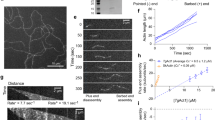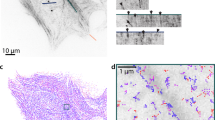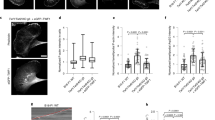Abstract
The filamins are cytoplasmic proteins that regulate the structure and activity of the cytoskeleton by cross-linking actin into three-dimensional networks, linking the cell membrane to the cytoskeleton and serving as scaffolds on which intracellular signaling and protein trafficking pathways are organized (reviewed in refs. 1,2). We identified mutations in the gene encoding filamin B in four human skeletal disorders. We found homozygosity or compound heterozygosity with respect to stop-codon mutations in autosomal recessive spondylocarpotarsal syndrome (SCT, OMIM 272460) and missense mutations in individuals with autosomal dominant Larsen syndrome (OMIM 150250) and the perinatal lethal atelosteogenesis I and III phenotypes (AOI, OMIM 108720; AOIII, OMIM 108721). We found that filamin B is expressed in human growth plate chondrocytes and in the developing vertebral bodies in the mouse. These data indicate an unexpected role in vertebral segmentation, joint formation and endochondral ossification for this ubiquitously expressed cytoskeletal protein.
This is a preview of subscription content, access via your institution
Access options
Subscribe to this journal
Receive 12 print issues and online access
$259.00 per year
only $21.58 per issue
Buy this article
- Purchase on SpringerLink
- Instant access to full article PDF
Prices may be subject to local taxes which are calculated during checkout





Similar content being viewed by others
References
Stossel, T.P. et al. Filamins as integrators of cell mechanics and signaling. Mol. Cell Biol. 2, 138–145 (2001).
Van der Flier, A. & Sonnenberg, A. Structural and functional aspects of filamins. Biochim. Biophys. Acta 1538, 99–117 (2001).
Niederman, R., Amrein, P.C. & Hartwig, J. Three-dimensional structure of actin filaments and of an actin gel made with actin-binding protein. J. Cell Biol. 96, 1400–1413 (1983).
Loy, C.J., Sim, K.S. & Yong, E.L. Filamin-A fragment localizes to the nucleus to regulate androgen receptor and coactivator functions. Proc. Natl. Acad. Sci. USA 100, 4562–4567 (2003).
Gorlin, J.B. et al. Human endothelial actin-binding protein (ABP-280, nonmuscle filamin): a molecular leaf spring. J. Cell Biol. 111, 1089–1105 (1990).
Takafuta, T., Wu, G., Murphy, G.F. & Shapiro, S.S. Human β-filamin is a new protein that interacts with the cytoplasmic tail of glycoprotein Ibα. J. Biol. Chem. 273, 17531–17538 (1998).
Chakarova, C. et al. Genomic structure and fine mapping of the two human filamin gene paralogues FLNB and FLNC and comparative analysis of the filamin family. Hum. Genet. 107, 597–611 (2000).
Sheen, V.L. et al. Filamin A and filamin B are co-expressed within neurons during periods of neuronal migration and can physically interact. Hum. Mol. Genet. 11, 2845–2854 (2002).
Himmel, M., Van Der Ven, P.F., Stocklein, W. & Furst, D.O. The limits of promiscuity: isoform-specific dimerization of filamins. Biochemistry 42, 430–439 (2003).
Fox, J.W. et al. Mutations in filamin 1 prevent migration of cerebral cortical neurons in human periventricular heterotopia. Neuron 21, 1315–1325 (1998).
Robertson, S.P. et al. Localized mutations in the gene encoding the cytoskeletal protein filamin A cause diverse malformations in humans. Nat. Genet. 33, 487–491 (2003).
Honeywell, C., Langer, L. & Allanson, J. Spondylocarpotarsal synostosis with epiphyseal dysplasia. Am. J. Med. Genet. 109, 318–322 (2002).
Steiner, C.E., Torriani, M., Norato, D.Y. & Marques-de-Faria, A.P. Spondylocarpotarsal synostosis with ocular findings. Am. J. Med. Genet. 91, 131–134 (2000).
Steiner, C.E. et al. A locus for spondylocarpotarsal synostosis syndrome at chromosome 3p14. J. Med. Genet. (in the press).
Larsen, L.J., Schottdstaedt, E.R. & Bost, F.C. Multiple congenital dislocations associated with characteristic facial abnormality. J. Pediatr. 37, 574–584 (1950).
Latta, R.J., Graham, C.B., Aase, J., Scham, S.M. & Smith, D.W. Larsen's syndrome: a skeletal dysplasia with multiple joint dislocations and unusual facies. J. Pediatr. 78, 291–298 (1971).
Marques, M.J. Larsen's syndrome: clinical and genetic aspects. J. Genet. Hum. 28, 83–88 (1980).
Vujic, M. et al. Localization of a gene for autosomal dominant Larsen syndrome to chromosome region 3p21.1-14.1 in the proximity of, but distinct from, the COL7A1 locus. Am. J. Hum. Genet. 57, 1104–1113 (1995).
Sillence, D., Worthington, S., Dixon, J., Osborn, R. & Kozlowski, K. Atelosteogenesis syndromes: a review, with comments on their pathogenesis. Pediatr. Radiol. 27, 388–396 (1997).
Nishimura, G., Horiuchi, T., Kim, O.H. & Sasamoto, Y. Atypical skeletal changes in otopalatodigital syndrome type II: phenotypic overlap among otopalatodigital syndrome type II, boomerang dysplasia, atelosteogenesis type I and type III, and lethal male phenotype of Melnick-Needles syndrome. Am. J. Med. Genet. 73, 132–138 (1997).
Schultz, C., Langer, L.O., Laxova, R. & Pauli, R.M. Atelosteogenesis type III: long term survival, prenatal diagnosis, and evidence for dominant transmission. Am. J. Med. Genet. 83, 28–42 (1999).
Wessels, M.W. et al. Prenatal diagnosis of boomerang dysplasia. Am. J. Med. Genet. 122, 148–154 (2003).
Sheen, V.L. et al. Mutations in the X-linked filamin 1 gene cause periventricular nodular heterotopia in males as well as in females. Hum. Mol. Genet. 10, 1775–1783 (2001).
Maquat, L.E. Nonsense-mediated RNA decay in mammalian cells: A splicing-dependent means to down-regulate the levels of mRNAs that prematurely terminate translation. in Translational Control of Gene Expression (Sonenberg, N., Hershey, J.W.B. & Mathews, M.B. eds.) 849–868 (Cold Spring Harbor Press, Cold Spring Harbor, New York, 2000).
Acknowledgements
We thank all the families who participated in this research; M. Priore, G. Rose and F. Field of the International Skeletal Dysplasia Registry for their assistance in collecting the families; N. Ehtesham for her assistance with preparing the figures; and K. Lyons for discussions regarding the expression of filamin B during mouse development. This work was supported in part by grants from the US National Institute of Health (to D.H.C., D.K. and D.L.R.), the Cedars-Sinai General Clinical Research Center, the Drown Foundation (to D.K.) and the National Organization for Rare Disorders (to J.M.G.). D.H.C. is the recipient of a Winnick Family Foundation Clinical Scholars award. S.P.R. and T.M. are supported by the Child Health Research Foundation of New Zealand.
Author information
Authors and Affiliations
Corresponding authors
Ethics declarations
Competing interests
The authors declare no competing financial interests.
Supplementary information
Rights and permissions
About this article
Cite this article
Krakow, D., Robertson, S., King, L. et al. Mutations in the gene encoding filamin B disrupt vertebral segmentation, joint formation and skeletogenesis. Nat Genet 36, 405–410 (2004). https://doi.org/10.1038/ng1319
Received:
Accepted:
Published:
Issue date:
DOI: https://doi.org/10.1038/ng1319
This article is cited by
-
Transcriptional reprogramming during human osteoclast differentiation identifies regulators of osteoclast activity
Bone Research (2024)
-
Loss of function mutation in Ank causes aberrant mineralization and acquisition of osteoblast-like-phenotype by the cells of the intervertebral disc
Cell Death & Disease (2023)
-
Intervertebral disc degeneration is rescued by TGFβ/BMP signaling modulation in an ex vivo filamin B mouse model
Bone Research (2022)
-
An orthodontic perspective on Larsen syndrome
BMC Oral Health (2021)
-
Spondylocarpotarsal synostosis syndrome due to a novel loss of function FLNB variant: a case report
BMC Musculoskeletal Disorders (2021)



